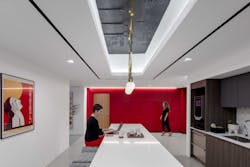Adapting Design Thinking to Ensure a Healthier, More Sustainable and Connected Future
Designers are always planning ahead. They see not only the aesthetic potentials of built environments, but more importantly, how they can better serve and communicate with the communities that will use them for years to come. The COVID-19 pandemic has complicated our relationship to physical space. However, designers are utilizing the current state of affairs as a meaningful opportunity to rethink shared spaces and make them healthier, more adaptable and more user-friendly, ultimately bringing us back together.
The virtual conversations that occurred during this year’s Community as Strategy webinar series, presented by KI and IIDA, regionally addressed just that. Throughout the series, designers, architects and design professionals came together to discuss their personal strategies for preparing for the future, whatever it may look like, and the ways in which design can continue to help us build a better world. Through design thinking, we can be prepared for anything.
Understanding the Impact of Design
As we head towards a future where health, safety and wellness are of utmost importance in almost everything we do and build, designers are also cognizant of the need for designing sustainably—whether that means repurposing materials, gaining a deeper understanding of waste streams or utilizing existing buildings to avoid hazardous demolition conditions. When it comes to sustainability, clients are savvier than ever, and they want assurance that design firms are employing creative, sustainable practices within projects.
“The larger conversation is about impact and understanding as a designer the many scales of impact that you have in the decisions you’re making,” says Amy Campos, IIDA, founder and principal of ACA and tenured associate professor and chair of interior design at the California College of the Arts. “We are constantly refreshing interiors and architecture, so we need a critical perspective on waste and sustainability.”
[Related: CertainTeed’s Ceiling Tiles Help Preserve Original Look of a Landmark NYC Building]
Part of designing for a better tomorrow also involves making certain that the spaces being envisioned are reflective of people’s stories and needs. This involves understanding and reacting strategically to who will use a project, who will be affected by it and what kind of difference it will make within a community. Understanding human impact goes hand-in-hand with an environmental impact conversation.
Branding for the Better
Our physical spaces, especially our offices, are often direct reflections of the culture and values we share as professional communities. A space is never just a space—it becomes a “place” when culture, brand and meaning is present in its conception and utilization. So, what happens to brand and culture when we cannot rally around physical space? How can designers continue to support our internal and external cultures when we are utilizing our workspaces less?
While clients still want to see themselves represented in the spaces they commission, a big picture branding plan that is coherent and accessible will ensure that a shared corporate goal doesn’t get lost within a work-from-home setting. Rachel Rouse, IIDA, director of interiors at HOK, states that for a retail brand like Shiseido, for example, culture and brand do not stop and start with the office space.
“When retail customers buy from Shiseido, they take a piece of the branding with them.” The nearly 150-year-old company is confident in its branding language and overall culture, making it easy for them to communicate who they are and what they stand for to customers both inside and outside of their headquarters. In a future where, corporate HQs may not always be public-facing offices, designers can assist their clients in developing a cohesive branding experience that touches many different aspects of their products and their output.
Understanding Community
As we work to better our shared spaces, we can simultaneously work to understand who is impacted, both negatively and positively, whenever a design project is built or a building gets repurposed. “Companies and organizations can no longer be disconnected from external communities,” says David Meckley, IIDA, principal at Huntsman Architectural Group. “Clients want to know how firms and organizations can actually be a part of the community they are building in.”
This can be a tricky and sensitive undertaking, especially when considering that those external communities may have already been touched negatively by gentrification and see a new design project as a part of a wider urban problem for themselves and their families. Meckley agrees that while it is often challenging, creating meaningful space for external communities within your built environment can and will ultimately benefit everyone.
Despite the temporary separation that we are all currently experiencing, community as a key element of design remains a constant foundational element for designers as they reform, rethink and plan for the future. As we emerge from this period, we can move closer to designing for togetherness.
Read Next: Consolidated Ceilings Resource for Commercial Architecture and Design Launched
